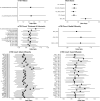Persistent MRI Findings Unique to Blast and Repetitive Mild TBI: Analysis of the CENC/LIMBIC Cohort Injury Characteristics
- PMID: 38401164
- PMCID: PMC11363162
- DOI: 10.1093/milmed/usae031
Persistent MRI Findings Unique to Blast and Repetitive Mild TBI: Analysis of the CENC/LIMBIC Cohort Injury Characteristics
Abstract
Introduction: MRI represents one of the clinical tools at the forefront of research efforts aimed at identifying diagnostic and prognostic biomarkers following traumatic brain injury (TBI). Both volumetric and diffusion MRI findings in mild TBI (mTBI) are mixed, making the findings difficult to interpret. As such, additional research is needed to continue to elucidate the relationship between the clinical features of mTBI and quantitative MRI measurements.
Material and methods: Volumetric and diffusion imaging data in a sample of 976 veterans and service members from the Chronic Effects of Neurotrauma Consortium and now the Long-Term Impact of Military-Relevant Brain Injury Consortium observational study of the late effects of mTBI in combat with and without a history of mTBI were examined. A series of regression models with link functions appropriate for the model outcome were used to evaluate the relationships among imaging measures and clinical features of mTBI. Each model included acquisition site, participant sex, and age as covariates. Separate regression models were fit for each region of interest where said region was a predictor.
Results: After controlling for multiple comparisons, no significant main effect was noted for comparisons between veterans and service members with and without a history of mTBI. However, blast-related mTBI were associated with volumetric reductions of several subregions of the corpus callosum compared to non-blast-related mTBI. Several volumetric (i.e., hippocampal subfields, etc.) and diffusion (i.e., corona radiata, superior longitudinal fasciculus, etc.) MRI findings were noted to be associated with an increased number of repetitive mTBIs versus.
Conclusions: In deployment-related mTBI, significant findings in this cohort were only observed when considering mTBI sub-groups (blast mechanism and total number/dose). Simply comparing healthy controls and those with a positive mTBI history is likely an oversimplification that may lead to non-significant findings, even in consortium analyses.
© The Association of Military Surgeons of the United States 2024.
Conflict of interest statement
The authors report no conflicts of interest.
Figures
Similar articles
-
Differences in Brain Volume in Military Service Members and Veterans After Blast-Related Mild TBI: A LIMBIC-CENC Study.JAMA Netw Open. 2024 Nov 4;7(11):e2443416. doi: 10.1001/jamanetworkopen.2024.43416. JAMA Netw Open. 2024. PMID: 39527059 Free PMC article.
-
Increased [18F]Fluorodeoxyglucose Uptake in the Left Pallidum in Military Veterans with Blast-Related Mild Traumatic Brain Injury: Potential as an Imaging Biomarker and Mediation with Executive Dysfunction and Cognitive Impairment.J Neurotrauma. 2024 Jul;41(13-14):1578-1596. doi: 10.1089/neu.2023.0429. Epub 2024 May 8. J Neurotrauma. 2024. PMID: 38661540 Free PMC article.
-
White Matter Hyperintensities and Mild TBI in Post-9/11 Veterans and Service Members.Mil Med. 2024 Nov 5;189(11-12):e2578-e2587. doi: 10.1093/milmed/usae336. Mil Med. 2024. PMID: 39002108 Free PMC article.
-
Nutritional Supplement and Dietary Interventions as a Prophylaxis or Treatment of Sub-Concussive Repetitive Head Impact and Mild Traumatic Brain Injury: A Systematic Review.J Neurotrauma. 2023 Aug;40(15-16):1557-1566. doi: 10.1089/neu.2022.0498. Epub 2023 Mar 14. J Neurotrauma. 2023. PMID: 36680752
-
Technological aids for the rehabilitation of memory and executive functioning in children and adolescents with acquired brain injury.Cochrane Database Syst Rev. 2016 Jul 1;7(7):CD011020. doi: 10.1002/14651858.CD011020.pub2. Cochrane Database Syst Rev. 2016. PMID: 27364851 Free PMC article.
Cited by
-
Circulating Brain-Reactive Autoantibody Profiles in Military Breachers Exposed to Repetitive Occupational Blast.Int J Mol Sci. 2024 Dec 21;25(24):13683. doi: 10.3390/ijms252413683. Int J Mol Sci. 2024. PMID: 39769446 Free PMC article.
-
Assessment of White Matter Changes Using Quantitative T1ρ Mapping in an Open-Field Low-Intensity Blast Mouse Model of Mild Traumatic Brain Injury (mTBI).Int J Mol Sci. 2025 Jun 6;26(12):5431. doi: 10.3390/ijms26125431. Int J Mol Sci. 2025. PMID: 40564895 Free PMC article.
References
Publication types
MeSH terms
Grants and funding
LinkOut - more resources
Full Text Sources
Medical
Research Materials


